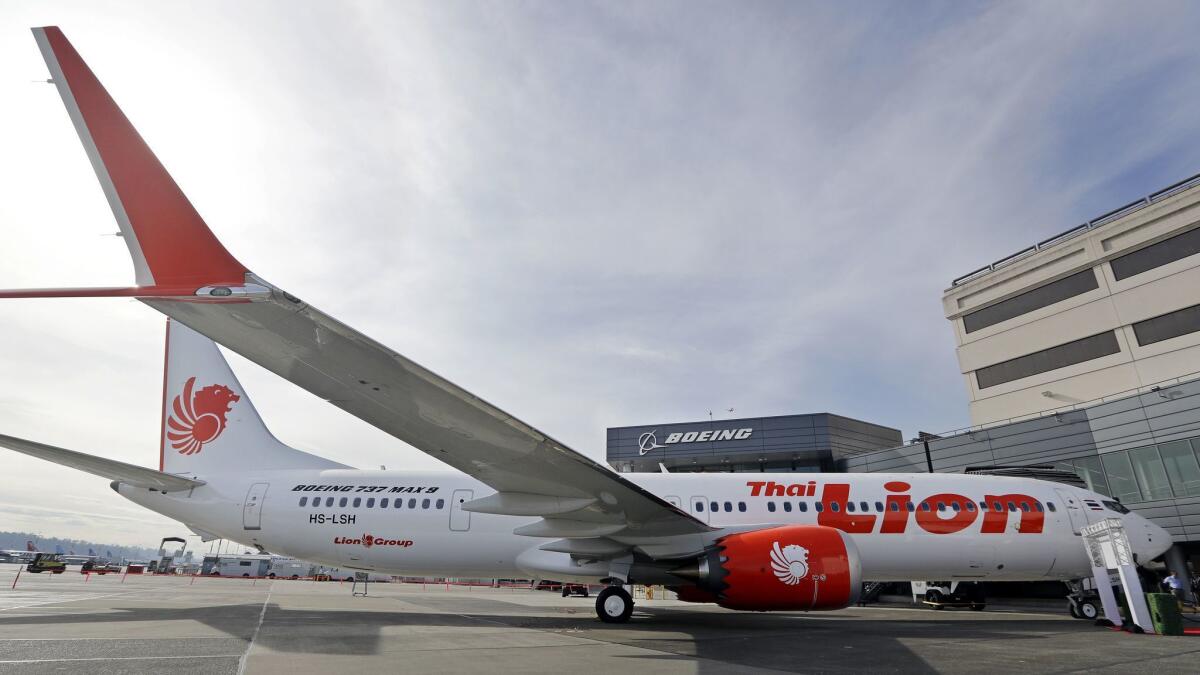What you need to know about the 737 MAX and the flight control system suspected in the Lion Air crash

Boeing’s popular 737 MAX aircraft and one of its flight control systems are now in the spotlight after the aircraft suddenly plunged into the sea last month, killing all 189 people aboard the Lion Air flight.
Investigators are still trying to figure out why the Boeing 737 MAX 8 plane crashed just minutes after takeoff from Jakarta, but Indonesian authorities have pointed to a safety flight control feature designed to prevent pilots from losing control of the aircraft, according to Bloomberg.
Read on to find out more about the plane, the system and whether Boeing could face liability for the crash.
What is the Boeing 737 MAX?
The 737 MAX is the latest model of Boeing’s popular single-aisle, twin-engine jet. The plane first flew in 2016 and is a direct competitor to Airbus’s A320 narrow-body jet.
Compared to prior versions of the 737, the MAX’s main selling point is fuel efficiency, said Richard Aboulafia, aviation analyst for Teal Group, an aerospace market research firm based in Fairfax, Va. Southwest Airlines said the Boeing 737 MAX 8 was “expected to significantly reduce fuel use” compared to the rest of its fleet, according to the airline’s annual report, filed in February. The 737 MAX’s advertised range is more than 4,430 miles, according to Boeing.
Norwegian currently uses its 737 MAX aircraft to fly transatlantic routes from the Britain and Ireland to New York and Providence, R.I.
Which U.S. airlines fly the 737 MAX?
Southwest Airlines (operates 26), American Airlines (16) and United Airlines (eight).
What is the system added to the 737 MAX that was reportedly involved in the Lion Air crash?
The Maneuvering Characteristics Augmentation System, also known as MCAS, is intended to assist pilots by automatically pulling the nose of the aircraft downward so the plane does not stall, said Bjorn Fehrm, an analyst with Leeham Co., an aerospace consulting and market analysis firm based in Washington. The system was designed to kick in only during extreme situations when the plane is pushing past normal flight limits, he said.
Fatal crashes have occurred when stall warnings weren’t heeded. In 2009, an Air France plane flying from Rio de Janeiro to Paris plunged into the Atlantic Ocean after one of the pilots pushed the plane’s nose up, despite repeated stall warnings. The plane fell into the ocean after about four minutes.
“It’s implemented to help the pilot when he’s really in deep trouble,” Fehrm said.
Pilots do not receive an alert when the MCAS system activates, said Capt. Dennis Tajer, spokesman for the Allied Pilots Assn., which represents American Airlines pilots.
Why was it added?
The MCAS system was added to make it easier for pilots to control the aircraft in extreme scenarios and prevent it from pitching up and stalling, Fehrm said. The 737 MAX is the only Boeing plane with this system.
To get more fuel efficiency, the 737 MAX’s engines needed a bigger diameter. That means the outer casing of the engine, known as the nacelles, is also larger, Fehrm said.
Because of that, the nacelles on the 737 MAX are located further forward on the wing than on previous versions of the 737. But those new engines now sit ahead of the aircraft’s center of gravity and that creates more lift for the plane, which could pitch the aircraft up, Fehrm said.
What was the reported problem with the system?
Investigators believe a sensor that indicates the demand on and performance of the wing sent erroneously high data about the angle of oncoming air and the aircraft’s wing to the MCAS flight system, which sent the plane into a dive.
The Federal Aviation Administration sent an emergency notice last week to owners and operators of the 737 MAX 8 and 737 MAX 9 warning that incorrect data from that sensor could lead to “repeated nose-down” commands of the plane’s horizontal stabilizer. If not addressed, the condition could make it difficult for the flight crew to control the plane, leading to “significant altitude loss and possible impact with terrain,” the notice said.
What has Boeing said about the plane?
The company said it is “taking every measure to fully understand all aspects of this incident” and is continuing to work with investigators and regulators. Boeing also said it has provided two updates for aircraft operators that “re-emphasize existing procedures for these situations.”
“We are confident in the safety of the 737 MAX,” the company said in a statement.
A Boeing official told the Wall Street Journal this week that the company decided not to give flight crews more details about the MCAS system so it would not overload pilots with too much information and technical data.
What have pilots said about the plane?
Tajer of the Allied Pilots Assn. said flight manuals for the 737 MAX aircraft did not have an explanation of the MCAS system. A union representing Southwest pilots told Bloomberg their manuals also did not include a description of the system.
“It’s not uncommon to have a system on an airplane that assists you when things are going astray,” said Tajer, who has flown the 737 MAX several times and flown 737 aircraft for 10 years. “But it’s very uncommon, unprecedented, for pilots to be not made aware of, and airlines that fly the planes to not be shown this in some manual.”
Could Boeing be liable for the crash?
It’s too soon to say, says Ahmed Abdelghany, professor of operations management at Embry-Riddle Aeronautical University’s College of Business. Many more factors need to be investigated, such as reports that the angle of attack sensor was replaced before the crash and what kinds of maintenance procedures were followed, he said.
“All of that has to be investigated,” Abdelghany said. “I would say it’s too early to just blame Boeing.”
Twitter: @smasunaga
More to Read
Inside the business of entertainment
The Wide Shot brings you news, analysis and insights on everything from streaming wars to production — and what it all means for the future.
You may occasionally receive promotional content from the Los Angeles Times.











